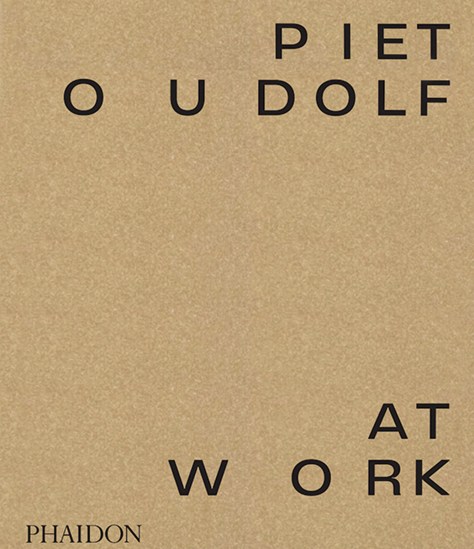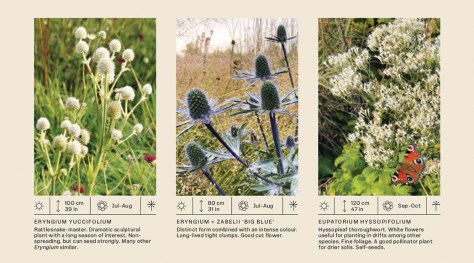Piet Oudolf At Work
By Piet Oudolf, with an introduction by Cassian Schmidt; London and New York City: Phaidon, 2023; 276 pages, $79.95.
Reviewed by Rosetta S. Elkin, ASLA
“For me garden design is not just about plants, it is about emotion, atmosphere, a sense of contemplation.” So begins Piet Oudolf in his latest monograph, At Work, adopting a tone of wisdom and mischief. The wisdom in this book is offered freely across a selection of hand-drawn planting plans that are reproduced with meticulous care. Each drawing offers a lesson to the reader in “How to Oudolf.” A kind of manual for designing nature without ecology is found in the series of artful drawings that reveal a strategy for working with plants through quantity, species, spacing, and cultivar. Here, he seems to say, is my secret recipe. The mischief is found in its provocation—go ahead, copy it. I dare you to try.
In any recipe, quantities matter. And Oudolf has a gift for measuring the elusive behavior of plants. Atmosphere is achieved in parts by calculation and proportion. At Work is a hefty volume chock-full of photographs in addition to drawings. Oudolf’s “healthy obsession with plants” comes through in the essays, quotes, and interviews. None of the essays are written by Oudolf, which is a relief. Because so many garden books are written by gardeners, they miss the essence of the projects, filling pages with instructions rather than context. The authors, however, widely quote his approach to design. A recipe is not an instruction, it is more flexible, and offers a way to share in obsession. For instance, when Oudolf says he works “in time and processes,” he gives a general indication of how to measure a plant while revealing that the effect is mostly magic.
Or mostly his magic. Work with the incorrect quantity and the effect will suffer.
Projects inserted between each essay offer a survey of Oudolf’s career and allow the reader a visual experience. There is a generous selection of sexy, verdurous images that confirm the breadth of his contribution to our times. But it is the hand-drawn planting plans that exemplify how plants are both a medium of human prediction and a collaborative expression between species. The planting plan transcends construction details and grading schemes because it details other living organisms. As a cartography, it references data and shapes geography. Moreover, its effect helps rework the relationship between plants and people in ways that deserve notice.
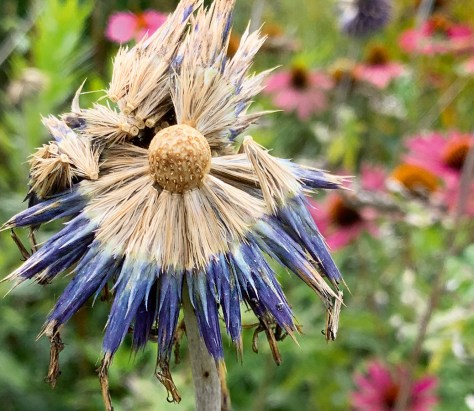
Oudolf’s planting plans in At Work are often difficult to decipher. The technical skill and agility of the artist obscure more than they reveal, even for the most plant-savvy reader. Still, the logic of tight clumps, flower skeletons, and neat seed heads are gracefully coded by colorful outlines, and indexed by playful notations that are technically impressive. Perhaps this is why the contributing authors in this publication insist that Oudolf is an artist, often justified by multiple claims that he works alone, surrounded by plants at his home and nursery.
A large photograph of Oudolf hard “at work” graces the opening pages. Other images of trace paper, archival storage, and a recently vacated desk chair reinforce the master narrative of the artist in his milieu, echoing a wealth of preceding books that play on this identity: Hummelo: A Journey Through a Plantsman’s Life (The Monacelli Press, 2021) and The Oudolf Gardens at Durslade Farm: Plants and Planting (Filbert Press, 2020). Each tome is a reminder that Oudolf’s prolific publishing career is as profuse as his “nature-like” style. The movement between textual essay and visual recipe in At Work confirms the paradox of Piet Oudolf, the contradictory suggestion that combining particular plant species creates a spontaneous, wild garden when in reality each project requires a lot of precise language to explain and justify.
The “naturalistic” style that Oudolf is known for is nature-like: of or relating to the qualities of nature. The style is also referred to as the New Perennial Movement and the Dutch Wave. Whatever it is called, it is a careful arrangement of plants to look unordered. As Cassian Schmidt, one of the practitioners of the New German Style, points out in the introduction: “Piet’s plantings, while strongly inspired by natural landscape models, are at the same time enhanced, scenically arranged and abstracted versions of nature.” Even Oudolf is uncomfortable with the association to nature and wildness. “I’ve always seen gardening as control,” he states in the interview with Hans Ulrich Obrist and Tino Sehgal. He goes on to compare traditional perennial gardening to “super-control” and his design style to celebrating growth at the edge of order. Plant development transpires at the threshold between control points. What is naturalistic about Oudolf’s style is the embrace of the full life cycle of a plant, which includes seed heads, defoliation, bud break, or decay. Landscape architects take note: What sets the style apart in public space is not the illusion of naturalness, but the confidence in plant life as a driver for design.
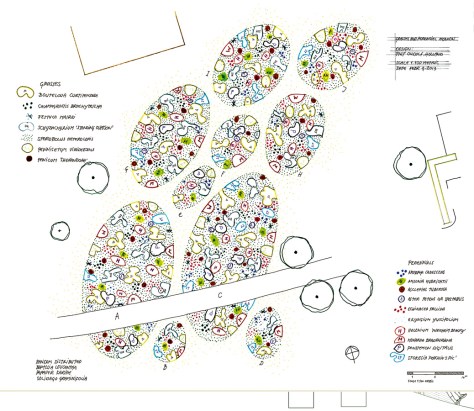
© Piet Oudolf.
Beyond style, planting design in landscape architecture is invigorated because Oudolf has undoubtedly brought gardens back to American parks: a river of European Salvia in Chicago, low carpets of Phlox stolonifera elevated in New York, and an ornamental matrix of Sesleria autumnalis in Detroit. Plant arrangements and combinations are selected for their expressive qualities and massing within what is often called a matrix planting. The matrix refers to the dominance of one long-lasting species that sets up a foundation for interplanting islands of contrasting and seasonally precise species, such as his signature Eryngium × zabelii ‘Big Blue.’ These two basic schemes are punctuated by a dash or a pinch of one kind or another, such as Allium spp. or Cornus mas. These are the contours of the Oudolf recipe, influenced by 30 years of plant-hunting trips, garden visits, and nursery experiments. One of Oudolf’s longtime collaborators, the British garden designer Noel Kingsbury, expands on influences in an essay by citing the creativity of fellow gardeners such as Mien Ruys and Gertrude Jekyll. I would also add the indelible resonance of Henk Gerritsen and Penelope Hobhouse for their contributions to plant collecting and seed sourcing. Each designer created gardens of great interest, but the influence stops there, because unlike Oudolf, there is no public expression of their work.
What other influences can explain the popularity of the “naturalistic” style and the Oudolf effect? In the final essay, “The Evolution of a Plantsman,” the founding editor of Gardens Illustrated, Rosie Atkins, extends the survey of this style in her essay on early influences in the designer’s life. Oudolf was raised next to Thijsse’s Hof, the Haarlem home and garden of the Dutch biologist Jacobus P. Thijsse (1865–1945), who is known for developing an ecological index of the wild plants of the reclaimed landscape in the Netherlands. Atkins is spot-on in identifying the wild beauty of Thijsse’s Hof as a foundational lesson in how gardens can be entirely designed to appear wild, an approach that also defined a period of park-making in the Netherlands and a significant example of the naturalistic style: the Dutch heempark tradition.
The Dutch word heem translates to “home” but alludes to habitat. Heemparks, or habitat parks, were conceived by Christiaan Pieter Broerse (1902–1995), an influential landscape architect who served as director of the parks commission for Nieuwer-Amstel. One of the best-preserved examples of the heempark tradition, Thijsse Park in Amstelveen, is named after the pioneer ecologist, who also influenced Oudolf. Broerse began his career at only 24, advocating for landscape preservation in a country that invented land-making—much of the Netherlands lies below sea level and is largely reclaimed from the sea. He witnessed the rise of encroaching development, drinking water extraction, and the overcultivation of heathlands as villages expanded into cities. Broerse was concerned for the loss of nature owing to urbanization, and his response was to conserve open areas through design, or more specifically, to advocate for planted public space.
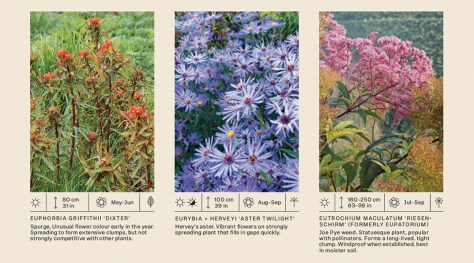
Advocacy is often the first step in landscape architecture projects. It is the most concealed design achievement, one that rarely gains notice in the profession. I highlight Broerse’s particular form of advocacy because it was steeped in an activism for gardens—rather than parks—as a civic expression driven by a confidence in planting design. Heemparks filled a gap in the efforts of spatial planners who otherwise only inserted large green patches in their plans, unarticulated parklands as public space. Heemparks offered an alternative: wild-looking gardens woven into small, interstitial areas between acquisitive housing projects. Profuse planting as a necessary part of civic experience.
For Broerse (and later Oudolf), a park was more than stretches of lawn spotted with shade trees and intersected by recreational activity. It was land planted densely and beautifully as a habitat. Broerse experimented with scale, redeveloping land of any size or condition. His designs were often admittedly imperfect or residual to a larger spatial planning project. Size was not the issue, as large parks including the Amsterdamse Bos were already supported by the commission. Heemparks featured the careful implementation of planting plans and prohibited sport-based recreation. This investment in complex herbaceous underplantings instead of lawn resonates with Oudolf’s approach. The perceived wildness of the heempark tradition remains and can be enjoyed across small parks, roadside gardens, and verges throughout the country. Thijsse Park remains one of the most effective and beloved heemparks, a jewel in Broerse’s advocacy efforts.
That Thijsse Park is often used in reference to Oudolf is noteworthy, because planting heemparks necessitated the design of a plant palette that could mimic an imaginary nature by creating artificial associations. Since all the land was reclaimed from the sea, the question of what was naturally occurring was irrelevant. Favored horticultural selections mimicked natural features including fen; Barbula convoluta (convoluted barbula moss) and Empetrum nigrum (black crowberry), and low forest; Salix repens (creeping willow) and Erica cinerea (bell heather), each species planted in masses to evoke an entire ecosystem. Flowering was associated with meadows; Primula vulgaris (primrose) and Anemone quinquefolia (wood anemone) were a favorite combination. At De Braak, Broerse carefully planned the park to weave in and out of a housing development, seemingly holding on to residual traces of the watery banks and introducing mass planting in waves across a largely unremarkable landscape.

Oudolf designs and plants in a similar tradition; by eliminating recreation and the pace of exercise, he advocates for plant time. By designing curving, looping footpaths, he slows down the pace of city life, and by designing with a profusion of long-lived herbaceous plants, one could argue, he advocates for emotion, atmosphere, and contemplation. In this regard, it is noteworthy to take in the sensitivities and devices that shape Oudolf’s work, as a significant contribution to landscape architecture in the public realm.
Landscape architecture has an uncomfortable relationship with planting design that ripples through practical and academic settings. No one seems equipped to explain why professional offices outsource planting so readily, why practitioners are rarely plant literate, or why students rarely learn advanced garden-making during their studies. James Corner, FASLA, in his contribution “Collaboration: An Evolving Process,” unpacks his office’s relationship with Oudolf, suggesting that major public projects necessitate a trusting collaboration between landscape architects and garden designers that responds to the further demands of clients, architects, artists, nurseries, soil specialists, and ecologists, among others. For the High Line, Corner explains how the relationship was fortified: “At the beginning of the design process, we would send drawings, plans, and images to Piet to communicate early structuring ideas and themes; he would mark them up, annotate them, send them back; we would further adapt, modify, and discuss them with Piet; he would again revise, update, and alter, and so the process continued through discussions and iterative drawings.”
There is a well-known axiom that there are no gardens without gardeners, which sheds light on the paradoxical gift of wisdom and mischief in Oudolf’s art: “I still love this over-the-top thing,” he claims in the interview with Obrist and Sehgal. So emerges the rationale for seriality and repetition, evident as a progression along the arc of his 30-year career. The wisdom of his early gardens is notable for the subtle scale, as planting is opportunistically shifted into narrows and bends. Do what you can with what you have. But the later drawings, and the images that accompany them, are vast and always lack context. The white page is analogous to the white cube. Consider that there are no topographic lines or features in any of the planting plans, a tradition that comes from a time when gardens were etched into landscapes, as the ground was cleared, weeded, and backfilled to create ideal conditions. Each planting plan also prudently leaves out reference to where plants are sourced, how they are grown, and the cost of daily, weekly, yearly, and decades-long maintenance. An undersized insert called “Planting the Vitra Garden” celebrates a flattened site, the application of spray paint across the topsoil, and a cheerful image of 30,000 plastic pots. The omission of the ecological impact of the design is not standard to landscape architectural practices, it is specific to Oudolf’s style, a part of the nature-like ambition of the work, “like” being the operative term.
Larger ecological implications and installation processes vibrate with Oudolf’s statement that he is addicted to an “over-the-top” aesthetic, suggesting the same mischief that enables Oudolf to deny context. Ground is cleared and prepared for the superimposition of the plan, a justification enhanced by raising his work to an art form. Unlike a landscape architect, Oudolf does not try to do otherwise. He is designing with the aforementioned emotion, atmosphere, and contemplation as driving forces, and he is honest and up-front about his motivations. In studying the arc of his career, interest in the living, misbehaving world fades across time, and as projects grow in scale and prominence, so too do planting density and quantity.
To return for a moment to Broerse, whose designs represent advocacy against accelerated urban planning procedures, it’s important to ask: Is it enough for design projects to offer beauty and bring joy without wider responsibility? Heemparks are the remnant indication of Broerse’s belief in civic life enhanced by wild, verdurous gardens. Oudolf’s evolution as a garden artist is found in the maturation of abundance. But given a context of hotter and thirstier public landscapes, the question of our time is not whether Oudolf’s gardens are natural enough, but how they weather change.
Rosetta S. Elkin, ASLA, is a practicing landscape architect and the academic director of the new MLA program at Pratt Institute in Brooklyn, New York.

